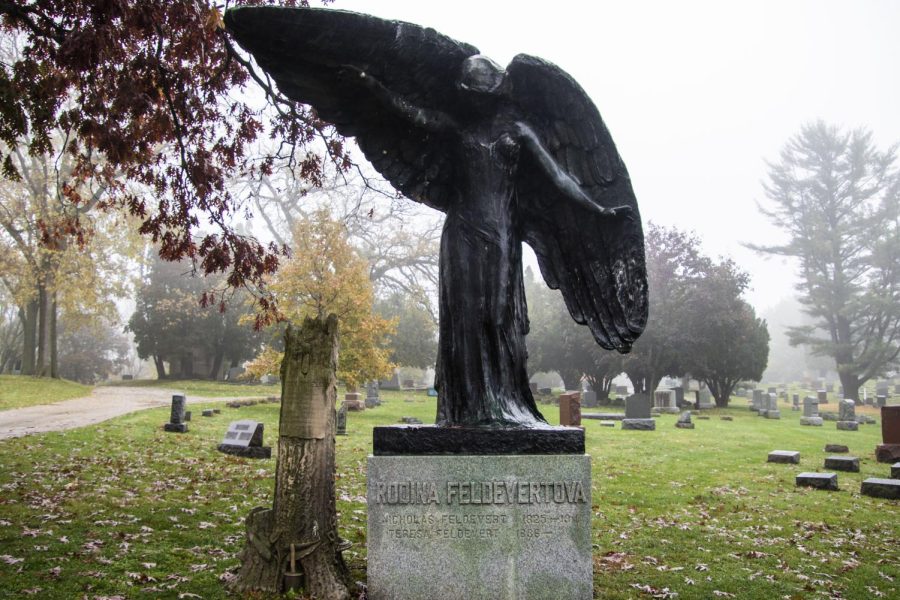Opinion | Respect for local graves should continue during Spooky Season
The meaning behind the Iowa City Oakland Cemetery and Black Angel.
The Black Angel is seen on Thursday, Oct. 22, 2020 in Iowa City.
October 23, 2022
The legacy of Iowa City’s Black Angel isn’t a new topic in Iowa lore.
With the leaves changing colors, the release of “Hocus Pocus 2,” and the hustle of midterms, traditions can be comforting during the chilly days leading up to Halloween.
But one tradition is better left behind this year and in the future: viewing the graves of the Feldevert family as a source of evil or demonic presence. Oakland Cemetery is located on the northside of Iowa City. The Black Angel statue sits in the cemetery on a short hill at the end of Reno Street.
In the early 1890s, this grave plot was where Czech-Bohemian immigrant Teresa Feldevert buried her only son, Edward “Eddie” Feldevert. Eddie was one of Teresa Feldevert’s two children during her lifetime; her first son died as an infant when she was still living overseas in what is now the Czech Republic.
To mark Eddie’s grave, Teresa Feldevert commissioned an ornate tree made of stone. Still there today, the stone tree is only a stump. Its purpose is to symbolize Eddie’s short life.
According to Black Angel historian and researcher Tim Parrot, Eddie’s death left Teresa Feldevert grief-stricken until her death in 1924. She and her husband Nicholas Feldevert chose to be buried in adjacent plots next to their son.
From base to wingtip, the statue stands 13 feet above Teresa and Nicholas Feldevert, its face turned toward Eddie’s grave. The angel is posed with a sad expression and a hanging head, which gives the impression of a family separated too soon and a mother’s love for her child — the latter outlasting all tragedies including death.
Rumors began to spread after the angel quickly turned black. Some people said the color change happened because Teresa Feldevert murdered her son Eddie in infancy. Others say she cursed the land on which the statue stands as part of her delusions while grieving for her son.
These are only two fictional versions of events about the Feldevert family, but historians know both to be inaccurate.
The scientific explanation for the Angel’s sudden color change is that its tarnished surface created its black appearance. Most likely, the oxidation process was exacerbated by Iowa’s cold winters and the use of salt on roads and walkways. Without routine upkeep, it makes sense the once shiny, golden-hued statue turned into shades of black and blue rust.
Of course, Black Angel tourists aren’t making the upkeep of the statue any easier.
“The fingers have been removed. People like to climb on it and hang on it,” Oakland Cemetery supervisor Russel Buffigton said in a comment to The Daily Iowan in 2017.
One local legend claims that removing one of the Angel’s fingers or kissing the statue after losing your virginity will lead to sudden death. Her seven missing fingers are proof some have taken these tales too seriously.
Whether you emphasize a mother’s loss, the struggles of immigration, or have a passion for beautiful art, we must all remember the legends of the Black Angel are harmful because they don’t focus on a family who suffered hardship and chose Iowa City as their final resting place.
Columns reflect the opinions of the authors and are not necessarily those of the Editorial Board, The Daily Iowan, or other organizations in which the author may be involved.



